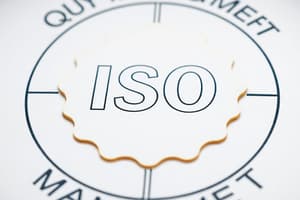Podcast
Questions and Answers
Which of these elements are interconnected in achieving organizational success?
Which of these elements are interconnected in achieving organizational success?
- Quality
- Competitiveness
- Customer Satisfaction
- All of the above (correct)
What is often considered the most important competitive weapon?
What is often considered the most important competitive weapon?
Quality
What does reliability refer to in the context of products or services?
What does reliability refer to in the context of products or services?
Consistency in performing as expected over time
What is a critical aspect of delivery that affects customer satisfaction?
What is a critical aspect of delivery that affects customer satisfaction?
Who proposed the 14 points for achieving quality excellence?
Who proposed the 14 points for achieving quality excellence?
Match the quality management figures with their contributions:
Match the quality management figures with their contributions:
What does Crosby’s definition of quality emphasize?
What does Crosby’s definition of quality emphasize?
Juran's approach emphasizes spontaneous improvements without structured methodologies.
Juran's approach emphasizes spontaneous improvements without structured methodologies.
What does Deming emphasize about leadership commitment?
What does Deming emphasize about leadership commitment?
What does the customer/supplier chain model focus on?
What does the customer/supplier chain model focus on?
What is one tool mentioned for effective quality management?
What is one tool mentioned for effective quality management?
Study Notes
Quality, Competitiveness, & Customer Satisfaction
- Quality, competitiveness, and customer satisfaction are interconnected and essential for organizational success.
- Reputation is a valuable asset built on quality, reliability, delivery, and price.
- Quality is the ability to meet or exceed customer expectations, differentiating companies from competitors.
- Reliability refers to consistent performance over time, reducing failure risk and enhancing reputation.
- Timely delivery is crucial for meeting customer expectations, and efficient logistics are vital.
Early TQM Frameworks
- Deming's 14 Points: Emphasis on shifting from inspection-based control to defect prevention and continuous improvement, advocating for employee empowerment, process optimization, and long-term improvement commitment.
- Juran's 10 Steps: Structured approach for identifying, analyzing, and addressing quality problems, emphasizing planning, control, and continuous improvement through structured problem-solving.
- Crosby's 4 Absolutes & 14 Steps: Focus on quality as conformance to requirements, with absolutes including prevention of defects, zero defects, and measuring quality in dollars. 14 steps guide implementation of quality principles within an organization, emphasizing leadership commitment, employee involvement, and a culture of continuous improvement.
Key differences between frameworks
- Deming: Focuses on employee empowerment and process optimization.
- Juran: Emphasizes structured problem-solving and collaboration.
- Crosby: Stresses leadership commitment and a culture of continuous improvement.
The Author's Early TQM Model
- Customer/Supplier Chain Store: Centers around interconnectedness of organizations and stakeholders, emphasizing understanding and meeting customer needs while managing supplier relationships for consistent quality.
- Surrounding Systems: Integrates quality management, information, and human resource management systems to support the customer/supplier chain and provide infrastructure for quality management.
- Tools: Recognizes the importance of using statistical process control, process mapping, and root cause analysis to identify and address quality problems effectively.
Studying That Suits You
Use AI to generate personalized quizzes and flashcards to suit your learning preferences.
Related Documents
Description
This quiz covers the essential concepts of quality, competitiveness, and customer satisfaction as they relate to organizational success. It also introduces early Total Quality Management (TQM) frameworks, including Deming's 14 points and Juran's 10 steps, focusing on continuous improvement and quality problem-solving techniques.




